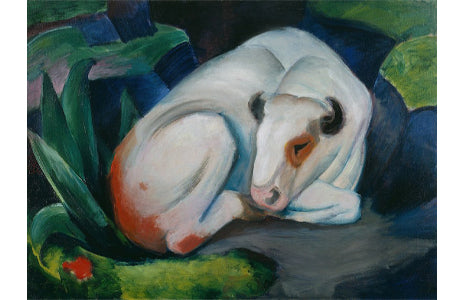How old is modern?
The colourful animals portrayed in the works of Franz Marc are as modern today as they were over one hundred years ago when he made them.
Marc wanted to “Express” meaning in his work rather than capture physical reality. His use of bright primary colours characterises his work. Marc’s aim was to attribute physical and emotional characteristics to the colours he chose.
Pupils will consider Marc’s Expressionist style and understand how, by copying the work of other artist’s, they can produce creative work. By using recycled materials, pupils will be able to make vivid artwork of their own in the style of Franz Marc.
Pupils will learn:
• About Franz Marc and a little more information about German Expressionism.
• To identify and understand what Expressionism means in art.
• To design a work of art using recycled materials.
• About the different methods artists use to express themselves.
Where to begin
Show pupils copies of Franz Marc’s animal portraits and ask them to estimate how long ago they were made. Look carefully at Marc’s animal imagery and discuss the Expressionist style. Encourage children to give characteristics to colours. Do they agree with Marc’s colour theory? What features would they give to other colours?
Look at how Marc’s technique is abstract and not realistic. Encourage the pupils to think about producing work inspired by Marc and to consider how, through examining the work of other artists, he developed his individualistic style.
At the craft stage, look through the materials you have available. Fabrics and paper can be cut and glued to craft paper to form the artwork.
The story of Franz Marc and the Expressionist Movement in Germany
Franz Marc was a German Expressionist artist born 1880 in Munich, Germany. In 1900, Marc studied art at the Munich Academy of Fine Arts. A few years later, he visited Paris and spent time exploring and copying the work of other artists.
Imitating and replicating is a traditional way for artists to create their unique style. One of the artists that inspired Marc was Vincent van Gogh.
Expressionism, in poetry and painting, originated in Germany at the beginning of the 20th Century. Expressionist art is designed to evoke ideas or moods. They wanted their work to express emotion rather than to reproduce reality.
When WW1 broke out in 1914, Marc was drafted into the German Army. In 1916, the German government gave orders for distinguished artists to be withdrawn from the battlefield, but Marc was killed in action before the order reached him.
How Marc used colour as a means of expressing emotions and physical meaning
As he grew as an artist Marc’s work became more abstract. Increasingly, he portrayed animals in their natural setting. These include The Tiger and Red Deer, The Tower of Blue Horses, Foxes, and Fate of the Animals in 1913.
Marc developed a method of symbolising emotion through colour. He uses blue to portray masculinity, sharpness and strength. Yellow represents femininity, gentleness and joy. Red signifies violence and brutality and is in opposition to the other two colours.
In Yellow Cow, we see a joyous cow leaping through the air. By using yellow as the central colour theme, Marc wants to express an underlying idea of happiness and femininity.
Here is an opportunity to discuss the way that colour can affect our mood. Warm colours: orange, yellow, red can make us feel warm. Cool colours: green, blue, purple can make us feel calm. Encourage children to look around the classroom and discuss the colours around them.
Design an Expressionist work of art
Pupils can review the portraits Marc made of various animals and reflect upon the way he uses colour to express the different characteristics of the animals. What do blue horses, white bulls and blue-black foxes represent?
Encourage children to think about what animal they would like to create and what materials they will use. Ask pupils to reflect on what colours they will use and which emotion or expression the colours represent.
If the class is to hold an art exhibition, they could consider each other’s work and discuss the use of colour and imagery. Do they find techniques used by other individuals useful and perhaps something they would consider using in the future? Pupils may reflect on the benefits of examining, reproducing and imitating other artists to improve individual creative skills.
How to extend the lesson
• Explore the ways in which other artists use recycled materials.
• Look at how artists from different cultures recycle everyday materials. El Anatsui is a sculptor from Ghana who transforms ordinary materials into stunning installations. One of his very famous pieces, Gravy & Grace, is made from discarded beer bottle tops!
• El Anatsui uses found materials that include sawdust, tin cans, driftwood and nails. By using recycled materials, Anatsui is highlighting the fact that in many countries, people have no choice but to use materials that have been thrown away.
• Are there items we throw away that we could reuse?

Useful questions to ask the pupils
• What do you know about Franz Marc and Expressionism?
• What materials will you use to create your work of art?
• What animal will you choose?
• What qualities and traits will you give the colours you use?

The Charlie Crow Art Kit
The Charlie Crow Art Kit includes over 1 kilogram of useful fabric swatches and can be used to create many art and craft activities.
The kits cost £10 each with free standard delivery included. You can receive a FREE Art Kit with every school order over £50.









